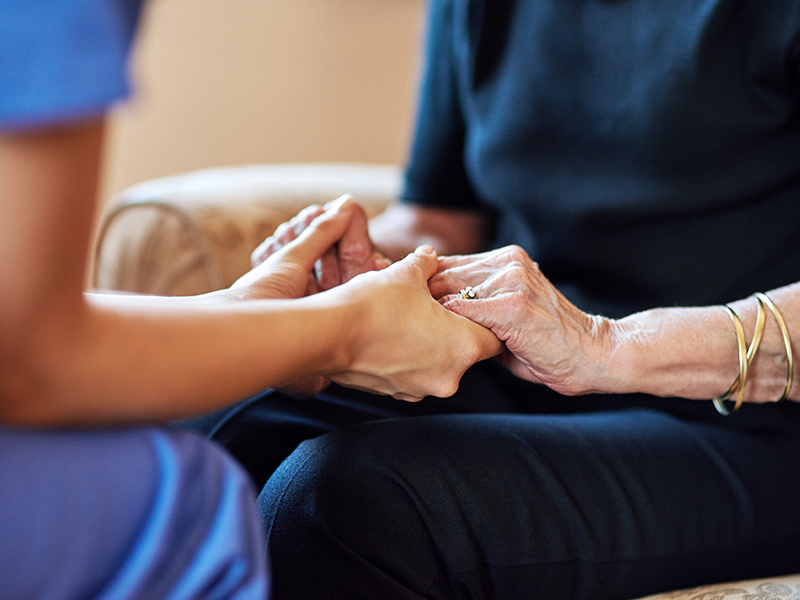Life after Ostomy Surgery
A new collaboration between The New Jewish Home and White Plains Hospital is providing hope and help for patients recovering from ostomy surgery.
When patients wake up from ostomy surgery, they are dealing with all the usual post-surgery issues — weakness, pain, and disorientation — plus “the reality that they are confronting a total change to their lifestyle, both physical and psychological,” according to Tina Nardi, ET Ostomy Specialist. She should know: As one of the pioneers in ostomy care, she has been counseling patients for more than 40 years. She was recently brought in to train the nursing staff at The New Jewish Home’s Sarah Neuman campus under a new partnership with White Plains Hospital designed to provide seamless care from surgery to rehab to discharge home.
Ostomy surgery, Nardi explains, is most often indicated when a life-threatening illness, such as cancer, ulcerative colitis or inflammatory bowel disease affects the digestive or urinary system. During surgery, bodily wastes are rerouted from the usual path to an external abdominal opening called a stoma. The stoma is then fitted with a pouch to catch the waste. “Patients are coming to grips with the fact that their body image has changed,” says Nardi. “They now have a pouching system to cope with elimination of body waste, which they have to learn to manage. They worry about leakage and odors and about getting back to work, their social life, their diet, intimacy.”
While patients receive some counseling in the hospital, their stay is often not long enough to learn to deal with all the physical and emotional issues surrounding their ostomy. As part of the collaboration with White Plains Hospital, patients are discharged to Sarah Neuman’s rehabilitation program, a state-of-the-art facility recognized for its excellence in restoring patients’ independence. Here, they may spend an average of 3-4 weeks regaining overall strength while learning how to physically manage their ostomy and to adjust psychologically. Length of stay varies due to protocols unique to the pandemic, and also due to other comorbidities that each client may present. “The goal,” according to Nadine Hall, Assistant Director of Nursing at Sarah Neuman, “is to be totally rehabilitated and equipped to function and cope once they go home.”
“Patient education begins on Day One and covers every aspect of ostomy care and coping,” according to Hall. Patients learn about the many products now on the market that make it easier to deal with issues like leakage and odors. There is an evaluation of patients’ physical ability to provide self-care as well as a psychological evaluation. “Some patients are very knowledgeable; they will give you instructions on how to care for their stoma. Others don’t even want to look at it or touch it.” Each patient gets individualized care tailored to their needs. “You have to know your patients. What will work with one will not work with another, so we try to see where they are in the process and let them know we are here for you. We have to be matter-of-fact and tell them this is not something you should be embarrassed about. We explain that many people have learned to lead normal lives with their ostomies and that we are dedicated to providing them with the resources they may need.” That includes referrals to support groups, training of family members and other caregivers and referrals to agencies that provide assistance once patients are discharged home.
While all Licensed Practical Nurses (LPNs) and Registered Nurses (RNs) get basic training in ostomy care in their regular training, the specialized, in-depth education they received from Nardi has strengthened their skills and broadened their knowledge. All the nurses who went through the training received a certificate of training in the management of patients who have undergone ostomy surgery. The nurses also have the option to further pursue wound ostomy care as a specialty if they choose to do so. Central to the training was exposure to the vast world of modern ostomy products designed to give patients greater physical and psychological comfort. “It’s like going to a shoe store: one size does not fit all,” says Nardi, who conducted the nine-session training over Zoom. “I shared pictures of different kinds of stomas and how to use different appliances and accessory products.” Nardi is the first to acknowledge that having a stoma — something that more than 700,000 Americans live with — is never easy. But, she reflects, “when I started out in the 1960s, people would leave the hospital with no education, and in terms of products, there was so little available. Thank God to be living in this age, when there is a growing number of trained personnel and so many great modern products available to make living with ostomies easier.”
The New Jewish Home has a proud legacy of empowering older adults to live with purpose and enhanced well-being. We’ve been around since 1848 as one of the nation’s first nursing homes, and now serving older New Yorkers of all backgrounds through a portfolio of health care services, including post-acute care and rehabilitation, skilled nursing, adult day care, assisted living, and at-home care.
See how we continue to elevate health care for older adults through our Research Institute on Aging and our SkillSpring program (formerly known as Geriatrics Career Development program), which empower teens and young adults to begin careers in health care.

